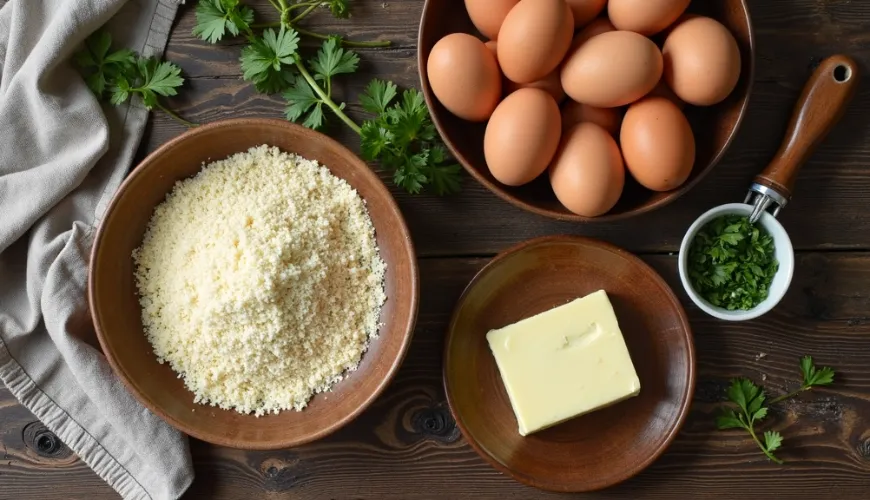
How to Achieve Perfect Grating for Soup That Will Captivate You

Grating for Soup - A Tasteful Return to Childhood
When you hear "grating for soup," many may think of a hot bowl of broth at grandma's, the scent of marjoram, and golden crumbs floating on the surface. This small, seemingly inconspicuous element of Czech cuisine has a rich tradition behind it – and even though it faces competition from modern ingredients and pre-made products today, it still holds its place of honor in many households. The best grating for soup is not just a matter of recipe but also of emotions and memories.
What Exactly is Grating for Soup?
Grating, sometimes referred to as soup thickener, is a crumbly mixture reminiscent of streusel, added to broths or vegetable soups. It's made from a few commonly available ingredients – usually eggs, semolina, sometimes flour, butter, and a pinch of salt. The mixture is grated or crumbled and briefly cooked in the soup, not only softening and thickening it but also adding depth and texture to the flavor.
Although it may seem like a culinary trifle, semolina soup grating is an example of simple culinary art that literally elevates an ordinary soup to a homemade delicacy. In various regions of the Czech Republic, it is prepared with slight variations – some add a pinch of nutmeg, others use butter instead of lard, or freshly chopped parsley is mixed into the mixture.
The Secret to Perfect Thickener
What makes grating truly good? It's the combination of consistency, taste, and the ability to blend with the soup without weighing it down. The best grating for soup should be light, crumbly, and moist at the same time – a golden middle ground between streusel and dumplings. Unlike pasta or dumplings, grating does not distract from the broth but rather supports it.
For example, Mrs. Marie from Vysočina, who has been making her grating for over forty years, says: "When I have a good broth from a home-raised chicken, I never add noodles or rice. Just my semolina grating. Nothing else enhances the flavor so naturally."
Semolina is the key ingredient in the recipe. Compared to plain flour, it has a coarser texture, allowing the grating to retain its shape after cooking and not turn the soup into porridge. Additionally, semolina is easily digestible and rich in complex carbohydrates, making it suitable for children's diets.
Grating for Soup – Traditional Recipe
So how to make grating for soup according to our grandmothers' recipe at home? You only need a few ingredients:
Ingredients:
- 1 egg (preferably at room temperature)
- 3–4 tablespoons of semolina (or coarse wheat semolina)
- a pinch of salt
- optionally: a tablespoon of butter, parsley, nutmeg
Instructions:
- Crack the egg into a bowl, add salt, and optionally melted butter.
- Gradually add the semolina while stirring constantly until a denser but still moldable mixture forms.
- Place the mixture in the fridge for a while to firm up – it will be easier to grate.
- Then grate it on a coarse grater onto a cutting board or tray.
- Let the grated mixture dry for a few minutes in the air. It's not necessary, but it helps with better consistency.
- Add to boiling soup and cook for about 2–3 minutes.
The result is light, fluffy, and slightly sweet due to the semolina. The grating absorbs the flavor of the broth beautifully without clouding or weighing it down.
When is the Right Time to Add Grating?
Timing is key in preparation. Grating should always be added to the finished, boiling soup – ideally just before serving. If cooked for too long, it might lose its structure and become mushy. The advantage is that prepared grated dough can be stored in the fridge for several days, and even frozen, so you can always add it to fresh broth as needed.
Where Does Grating Belong – and Where is it Replaced by Something Else?
While grating is excellent for classic chicken broth, vegetable soup, or garlic soup, it makes more sense to add grains, potatoes, or bread to thicker soups like goulash or bean soup. Grating for soup works best with clear broths that need gentle thickening and enrichment without overpowering the original taste.
In some households, it is also used as a base for various soup dumplings – just add a bit of baking powder, chopped parsley, cottage cheese, or grated cheese, form small balls, and cook instead of classic grating.
Homemade vs. Store-bought – Is It Worth Making Grating Yourself?
In an era when stores are full of soup thickeners and instant mixes, one might wonder: why bother making a homemade version? The answer is simple – taste and control over ingredients. Most industrially produced mixes contain preservatives, thickeners, or yeast extracts, which often unnecessarily burden the body.
Homemade grating, on the other hand, offers not only the purity of ingredients but also the ability to customize the recipe to your own taste. Want more protein? Add a second egg. Need a gluten-free version? Use buckwheat semolina or corn flour. The possibilities are almost limitless.
Grating in Modern Cuisine
Even though such a traditional ingredient might seem out of place in a world of quinoa salads and fermented foods, the opposite is true. Small culinary elements like grating for soup are returning today as part of the trend of returning to roots. Many chefs and nutritionists today emphasize that simple, homemade meals often offer the best combination of nutrition, taste, and sustainability.
Moreover, making grating generates almost no waste. You don't need any special packaging, no foreign ingredients, no single-use products. All you need is what you probably already have at home.
As the renowned Czech chef Roman Paulus says: "When you make a good soup, you don't need complex sides. Sometimes just a piece of bread or homemade grating is enough. There is beauty in simplicity."
And it is this beauty of simplicity that is why grating for soup should return to everyday cooking – not just as a nostalgic element, but as a practical and tasty part of a healthy homemade kitchen.
So next time you're making broth, try opting for an egg and semolina instead of pasta. You might discover not only a forgotten taste but also a new culinary passion.

